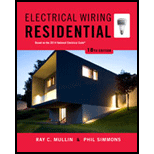
Electrical Wiring Residential
18th Edition
ISBN: 9781285170954
Author: Ray C. Mullin, Phil Simmons
Publisher: Cengage Learning
expand_more
expand_more
format_list_bulleted
Concept explainers
Question
Chapter 1, Problem 17R
To determine
Mention if the word “shall” appear in the NEC reference and whether it will be “must be done” or “may be done”.
Expert Solution & Answer
Trending nowThis is a popular solution!

Students have asked these similar questions
Pls show neat and whole solution
Pls show neat and whole solution
Pls show neat and whole solution
Chapter 1 Solutions
Electrical Wiring Residential
Ch. 1 - What is the purpose of specifications?Ch. 1 - Refer to the specifications in the back of this...Ch. 1 - What is done to prevent a plan from becoming...Ch. 1 - Name three requirements contained in the...Ch. 1 - Prob. 5RCh. 1 - What phrase is used when a substitution is...Ch. 1 - What is the purpose of an electrical symbol?...Ch. 1 - Prob. 8RCh. 1 - Prob. 9RCh. 1 - What three parties must be satisfied with the...
Ch. 1 - Prob. 12RCh. 1 - Prob. 13RCh. 1 - Does the NEC provide minimum or maximum standards?...Ch. 1 - What do the letters UL signify?Ch. 1 - What section of the NEC states that all listed or...Ch. 1 - Prob. 17RCh. 1 - Prob. 18RCh. 1 - Does compliance with the NEC always result in an...Ch. 1 - Name two nationally recognized testing...Ch. 1 - Prob. 21RCh. 1 - Prob. 23RCh. 1 - A junction box on a piece of European equipment is...Ch. 1 - Prob. 25RCh. 1 - You will learn in Chapter 3 that residential...Ch. 1 - Prob. 27RCh. 1 - What can you do to reduce or eliminate the...Ch. 1 - What is the NEC definition of a qualified person?Ch. 1 - Are low-voltage systems totally safe? Explain.Ch. 1 - Prob. 32RCh. 1 - What do the letters PPE stand for?...Ch. 1 - Prob. 34RCh. 1 - Where might you obtain information about...Ch. 1 - Prob. 36R
Knowledge Booster
Learn more about
Need a deep-dive on the concept behind this application? Look no further. Learn more about this topic, electrical-engineering and related others by exploring similar questions and additional content below.Similar questions
- Find the valve of voltage V, and Va using LOOP analys is C ЗА Mw 8 ДАДА 2 Am 4 38 + V Z 4 5A 34 2 12Varrow_forward1. For the following logic gates: a. Write a Truth Table and logic equation? A Y A A. Y A Y "0" A A neotoof "0"> Day Y "1" A ADY DY A B DD A B b. What each of these gates represent? 2. Connect and draw the following digital logic equations: a. Y=X+1 b. Y=X+X' = \ c. Y=X X' d. Y=X 0 e. Y=XX' f. Y=XOX 3. Prove that: a. X(Y+Z)=XY+XZ b. X+YZ=(X+Y)(X+Z) c. (X+Y)'=X'Y' d. (XY)'=X'+Y e. X+XY=X f. X(X+Y)=Xarrow_forwardI need help with this problem and an step by step explanation of the solution from the image described below. (Introduction to Signals and Systems: Spectrum Representation)arrow_forward
- I need help with this problem and an step by step explanation of the solution from the image described below. (Introduction to Signals and Systems: A complex Numbers)arrow_forward5) Find the value of voltage V, and V₂ using Loop analysis. 5A + 4 34 ww 8 2 www 3A m 4 38 + 23V₂ 1/2 + ±) 12Varrow_forward4) Find the valve of voltage Vx using Loop analysis. 2A ( 1 3 w + 234 OV + 123arrow_forward
arrow_back_ios
SEE MORE QUESTIONS
arrow_forward_ios
Recommended textbooks for you
 EBK ELECTRICAL WIRING RESIDENTIALElectrical EngineeringISBN:9781337516549Author:SimmonsPublisher:CENGAGE LEARNING - CONSIGNMENT
EBK ELECTRICAL WIRING RESIDENTIALElectrical EngineeringISBN:9781337516549Author:SimmonsPublisher:CENGAGE LEARNING - CONSIGNMENT Electricity for Refrigeration, Heating, and Air C...Mechanical EngineeringISBN:9781337399128Author:Russell E. SmithPublisher:Cengage Learning
Electricity for Refrigeration, Heating, and Air C...Mechanical EngineeringISBN:9781337399128Author:Russell E. SmithPublisher:Cengage Learning

EBK ELECTRICAL WIRING RESIDENTIAL
Electrical Engineering
ISBN:9781337516549
Author:Simmons
Publisher:CENGAGE LEARNING - CONSIGNMENT

Electricity for Refrigeration, Heating, and Air C...
Mechanical Engineering
ISBN:9781337399128
Author:Russell E. Smith
Publisher:Cengage Learning
Star Delta Starter Explained - Working Principle; Author: The Engineering Mindset;https://www.youtube.com/watch?v=h89TTwlNnpY;License: Standard Youtube License